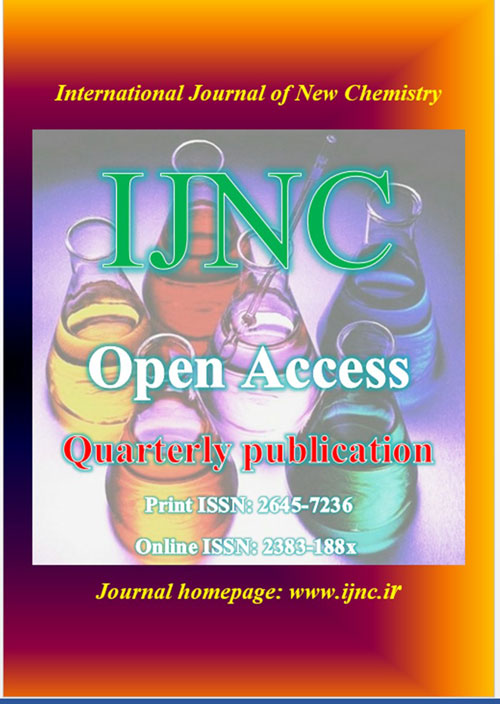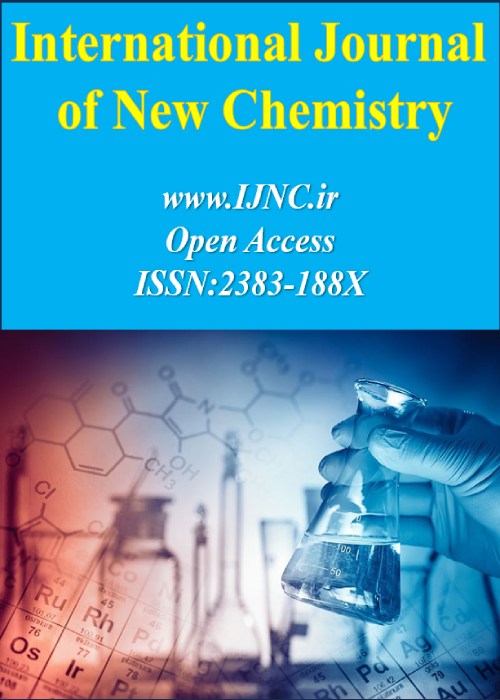فهرست مطالب

International Journal of new Chemistry
Volume:8 Issue: 2, Spring 2021
- تاریخ انتشار: 1400/04/06
- تعداد عناوین: 8
-
Pages 131-141
A series of 20 compounds isolated from some pyrazole derivatives were subjected to cytotoxicity test against HIV–1. Two statistical approaches namely: Genetic Function Algorithm (GFA) and Multi Linear Regression Analysis (MLRA) were effectively used. Best three descriptors which are: VR2_Dzv, VR1_Dzp and PubchemFP824 were selected for the Quantitative structural and activity relationship (QSAR) using the two aforementioned statistical approaches. The results obtained were as follows: R-squared (R2) of 0.9698, adjusted squared (R2adj) of 0.9607, cross validated R-squared (LOO- Q2cv) value of 0.9299 and external prediction ability (R2pred) of 0.6827. The result proved that the compounds are attractive platform and clinically viable for developing anti HIV-1 drugs. Multivariate statistics with chemical descriptors molecular shape and polarizability may be useful for the evaluation of cytotoxicity of pyrazole.
Keywords: QSCR, Pyrazole Derivatives, Anti-HIV-1, Validation, Cytotoxicity -
Pages 142-148
Nitrogen containing hetero cyclic compounds constitute the interior structure of a number of biologically attracted compounds against bacteria and fungi. The synthesis of carbazole derivatives have been desire due to their importance in medicinal field. Enhanced approach of Fischer’s synthesis followed by bromoacetylation have been used to synthesis four different carbazole derivatives, namely 1-bromo-2-(6-bromo-1,2,3,4-tetrahydro-9H-carbazol-1-yl) ethanone, 1-bromo-2-(5-bromo-1,2,3-trihydrocyclopenta[b]indole-1-yl) ethanone. The synthesized compounds were identified and confirmed using spectral techniques Viz, FTIR, 1H NMR, 13C NMR, MASS Spectroscopy. Antibacterial evaluation of synthesized compounds found to have pronozed antibacterial activity.Nitrogen containing hetero cyclic compounds constitute the interior structure of a number of biologically attracted compounds against bacteria and fungi. The synthesis of carbazole derivatives have been desire due to their importance in medicinal field. Enhanced approach of Fischer’s synthesis followed by bromoacetylation have been used to synthesis four different carbazole derivatives, namely 1-bromo-2-(6-bromo-1,2,3,4-tetrahydro-9H-carbazol-1-yl) ethanone, 1-bromo-2-(5-bromo-1,2,3-trihydrocyclopenta[b]indole-1-yl) ethanone. The synthesized compounds were identified and confirmed using spectral techniques Viz, FTIR, 1H NMR, 13C NMR, MASS Spectroscopy. Antibacterial evaluation of synthesized compounds found to have pronozed antibacterial activity.
Keywords: Bromoacetyl bromide, Ciprofloxacin, novel carbazole -
Pages 149-163
Corrosion reactions are often complex heterogeneous reactions that are accelerated by interactions such as: common kinetic considerations, electrolyte chemical composition, mass transfer between the electrolyte and the metal surface, Different surface effects such as adsorption, desorption and surface hardness are determined. The interactions between these factors make it difficult to reproduce electrochemical data or precise conditions that cause a metal to be corroded. These are the experimental factors that must be considered when corrosion tests are being designed. Ignoring these factors can produce data that does not provide the true corrosion behavior of the test metal under study. This paper presents the relationship between the inherent errors of corrosion measurement and suggestions on how to handle variability of electrochemical data.
Keywords: Corrosion reactions, Interaction rate, Activation Energy, electrochemical data -
Pages 164-172This study relates to an improved method for the preparation of azodicarbonamide (ADCA). Blowing agents are substances that decompose or vaporize easily at given temperatures to produce large quantities of gases. This property of blowing agents is utilized in the manufacture of various foams and sponges which are characterized by their extensive cellular structure and low ratio of weight to volume. Foam materials, especially plastic foams, have wide application, including such familiar uses as thermal insulation, life jackets, seat cushions, and package fillers. Azodicarbonamide is a well-known blowing agent. It is an organic compound which at between about l60- 200 ˚C evolves into a gas, the principal constituent of which is nitrogen. Modified azodicarbonamides suitable for use as a blowing agent for high molecular substances having low softening points are prepared by oxidizing hydrazodicarbonamide in aqueous suspension by means of hydrogen peroxide in the presence of a bromine compound. By Series of comparative experiments, Factors of influencing the yield of azodicarbonamide are studied, such as reaction time, type of catalyst and the amount of catalyst. Under the optimum process conditions, the yield of ADCA can reach over 95%.Keywords: azodicarbonamide, Hydrazodicarbonamide, Blowing agent, Oxidant, catalyst
-
Pages 173-180One of the advancements of the present century is the use of carbon nanotubes in the treatment of cancer. As the carbon nanotubes pass through the cell wall, the anticancer drug is transferred to the cancer tissue and released. The purpose of this project is to obtain the thermodynamic functions and potential energy of the interaction between melphalan anticancer drug and functionalized carbon nanotube. The potential energy of this interaction is obtained by Monte Carlo simulation at different temperatures in the gas, methanol and water phases and the thermodynamic functions of this interaction is obtained by quantum mechanics by the density function theory with B3LYP/6-311G basis set at different temperatures in the gas, methanol and water phases. The results show that the Gibbs free energy and entropy are a function of the solvent dielectric constant. So that the Gibbs free energy and entropy changes of reaction are decreases and increases respectively. Also the results of both methods indicate that the best environment for this interaction is water solvent.Keywords: Monte Carlo Simulation, melphalan, Interaction, Carbon Nanotube, thermodynamic
-
Pages 181-197
Increasing globalization trends, information and Communication technologies developments including the network community expands, new media and educational innovations have enabled us to use technology to learn more as well as more efficiency and management on knowledge. However, in recent years, knowledge management has become a familiar word for today's societies and industries, and knowledge management has gained popularity, especially in the education and business sectors but its effects on new educational systems has not been much studied. Systems such as the Learning Management System (LMS), which play an important role in learning employees and employees of corporations and industrial societies, and even banks and educational centers. In this study, considering the positive and negative effects of the LMS learning system on learning, we examine its effects on knowledge sharing and then knowledge management. Using the questionnaire, we collect the data and analyze the effects by regression analysis.
Keywords: LMS, Knowledge sharing, Regression, Knowledge Management -
Pages 198-221All calculations were performed within the MP2 / 6-311 G (d, p) method to evaluate the effects of substituent groups which affect the structural stability and molecular energy. A natural bond orbital (NBO) analysis and isotopic, and anisotropic NMR chemistry, were used also for a better understanding of the C2X4 electronic structure and its derivatives. The NBO analysis shows that the occupancy of lone pair electrons of halogen atoms in all compounds decreases with increasing p character of the lone pair of halogen atoms. Furthermore, NBO analysis demonstrated the effects of donates substituent groups including (CH3, NH2, and OH) that donates some of its electron density into a π system via resonance or inductive effects, thus making the π system more nucleophilic on electron density. The obtained values from NMR tensors parameters shows electronegativity in excellent agreement with the expected chemical shielding values. Therefore, we suggest that is correlations between donates substituent groups with electronegativity along with the total stability energy of the studied molecules. The energies gap of frontier molecular orbital (ɛLUMO- ɛHOMO) is recorded in order to find the suitability correlation between this energy with chemical hardness (η) of the studied molecules.Keywords: : MP2 method, NBO analysis, NMR shielding, HOMO-LUMO
-
Pages 222-228γ-Al2O3/ NiO/ TiO2 as a novel photocatalyst that is active in visible light was synthesized by a simple sol-gel method. The prepared samples were characterized by XRD, DRS-UV/Vis, and TEM analysis. The photocatalytic effect of synthesized samples was examined on methyl tert-butyl ether (as a model hazardous contaminant) degradation. Experimental condition including pH, irradiation time, and photocatalyst mass were optimized. Overall, the UV/Vis spectrophotometry results indicated that the synthesized nanoparticles have an extraordinary photocatalytic activity for the degradation of methyl tert-butyl ether under visible light.Keywords: Photodegradation, Nanocomposite, Core-shell, Titanium dioxide, methyl tert-butyl ether


